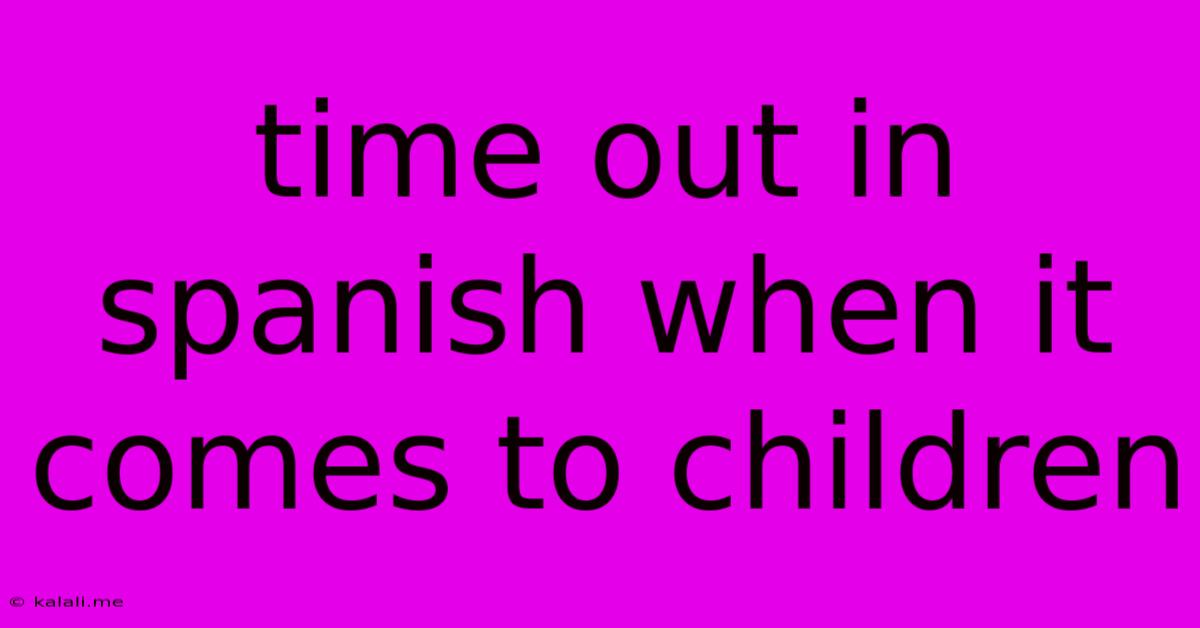Time Out In Spanish When It Comes To Children
Kalali
May 23, 2025 · 3 min read

Table of Contents
Understanding "Time Out" in Spanish: A Guide for Parents
Are you a Spanish-speaking parent, or perhaps raising children in a Spanish-speaking home? Understanding effective discipline strategies is crucial, and the concept of "time out" – while familiar in many cultures – requires careful consideration within the Spanish-speaking context. This article explores different approaches to time outs in Spanish, offering advice on implementation and cultural nuances. We'll explore effective alternatives and ways to ensure a positive impact on your child's behavior.
What is a Time Out, and Why Use It?
A time out is a short period of separation for a child who is misbehaving. The goal isn't punishment, but rather to give the child a chance to calm down, reflect on their actions, and learn self-regulation. In Spanish, you might hear it referred to as "tiempo fuera," "un tiempo a solas," or "descanso." The specific term isn't as important as the underlying principle: providing a calm space for reflection. It's a valuable tool for managing challenging behaviors in children of various ages, from toddlers to pre-teens. This method helps children understand consequences without resorting to harsh punishment.
Implementing "Tiempo Fuera" Effectively: Tips for Parents
While the concept is simple, effective implementation requires a nuanced approach:
- Consistency is Key: Establish clear rules and consistently enforce the time-out procedure. Inconsistency undermines its effectiveness.
- Age-Appropriate Duration: The length of the time-out should correspond to the child's age. A good rule of thumb is one minute per year of age. For very young children, even 30 seconds can be sufficient.
- Calm and Neutral Tone: Avoid emotional outbursts. Explain calmly why the time-out is necessary, focusing on the child's behavior, not their inherent character. Phrases like "Necesitas un tiempo fuera para calmarte" (You need some time out to calm down) or "Vamos a tomarnos un descanso" (Let's take a break) can be effective.
- Safe and Boring Location: Choose a designated spot – a chair, a corner – that's free from distractions and stimulation. The idea is not to punish, but to offer a space for self-reflection.
- Positive Reinforcement: Following the time-out, praise the child's calm behavior and focus on positive reinforcement of desired behaviors. Explain how they can make better choices next time.
- Avoid Power Struggles: Time-outs should be a tool for self-regulation, not a battle of wills. If your child resists, calmly guide them to the designated spot, and remain calm.
Cultural Considerations and Alternatives
The approach to discipline varies across cultures. While "tiempo fuera" is widely adopted, consider your child's cultural context. Some families may find alternative methods more effective, such as:
- "El Rincón de Pensamiento" (The Thinking Corner): This can be a more positive framing, emphasizing reflection rather than punishment.
- Loss of Privileges: Removing screen time or other privileges can be a suitable alternative or supplement to time-outs.
- Positive Reinforcement: Focusing on rewarding positive behavior can be far more impactful than only punishing negative actions.
- Family Meetings: Involving children in discussions about their behavior and establishing family rules can foster a sense of responsibility and ownership.
When Time Outs Might Not Be Suitable
Time-outs might not be the ideal approach for all children and situations. Consider consulting a child psychologist or behavioral specialist if you're struggling to manage your child's behavior effectively. Sometimes underlying issues, such as anxiety or other developmental challenges, might require a different approach.
Remember, the goal is to help your child learn self-regulation and develop healthy coping mechanisms. The right approach may involve a combination of strategies, adapted to your child's unique needs and your family’s cultural context. By focusing on communication, understanding, and consistency, you can create a positive and supportive environment for your child to thrive.
Latest Posts
Latest Posts
-
Bed Circular Tiny Round Black Bugs
May 23, 2025
-
How To Stop A Text Message
May 23, 2025
-
Why Did Voldemort Want To Kill Harry
May 23, 2025
-
What Time Does Orlando Airport Open
May 23, 2025
-
Taylor Series Of 1 1 X 2
May 23, 2025
Related Post
Thank you for visiting our website which covers about Time Out In Spanish When It Comes To Children . We hope the information provided has been useful to you. Feel free to contact us if you have any questions or need further assistance. See you next time and don't miss to bookmark.